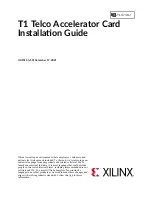
• Optional use of fronthaul ports for a midhaul (F1) interface between distributed and
centralized units (DU and CU)
• 4G LTE and 5G NR inline acceleration of L1 functions (supporting 3GPP split option 7-2x) for
up to 4TRX
The T1 card turns a standard server into a virtual baseband unit with the performance, low
latency, and power efficiency needed for O-RAN 5G deployments. The turnkey solution enables
operators, system integrators, and OEMs to get to market quickly and to simplify the deployment
of services at the edge.
Minimum System Requirements and Setup
The minimum system requirements for running a T1 Telco accelerator card are shown below:
Table 1: Minimum System Requirements
Component
Requirement
Motherboard
PCI Express 3.0 compatible with one dual-width x16 slot.
System power supply
75W through a PCI Express slot connection
Operating system
Linux, 64-bit:
CentOS 7 and 8
Ubuntu 16, 18, and 20
System memory and CPU cores
For deployment installations, a minimum of 16 GB plus
application memory requirements is required. For
development installations, a minimum of 64 GB of device
memory is required, but 80 GB is recommended.
A minimum of 16 logical cores is required.
Internet connection
Required for downloading drivers and utilities.
Hard disk space
Satisfy the minimum system requirements for your
operating system.
Auxiliary power supply
No auxiliary power supply is required because the T1 card
cannot boot standalone.
Vitis™ application acceleration development flow
The Vitis™ application acceleration development flow is not
currently supported.
The T1 Telco accelerator card is intended for deployment on most servers. Currently, thermal
testing has been conducted on a Dell R640, and functional testing on a number of additional
servers including Dell R730 and R740.
Chapter 1: Introduction
UG1518 (v1.0) December 17, 2021
T1 Telco Accelerator Card Installation Guide
5




















